| OCTOBER 2025 |
| Misonoza (Nagoya) |  |
| Dates | 11 ~ 26 October 2025 Kichirei Kaomise Annual Festive Face-Showing Program |
| MatinÚe | |
| Evening | |
| Casting |
Onoe Kikugor˘, Onoe Kikunosuke, Nakamura Jakuemon, Nakamura Kinnosuke, Band˘ Hikosabur˘, Nakamura Tokiz˘, Nakamura Mantar˘, Kataoka Kamez˘, Kamimura Kichiya, Ichimura Manjir˘, Kawarasaki Gonjűr˘, Nakamura Takanosuke, Sawamura Kiyoshir˘, Kamimura Kichitar˘, Nakamura Shinobu, Onoe Kikushir˘, Onoe Kikuichir˘ |
| Comments |
51st edition of the classic October kaomise programs in Nagoya! The previous edition was in ... October 2019! Onoe Kikugor˘ VIII and Onoe Kikunosuke VI celebrate their shűmei in Nagoya at the Misonoza.
|
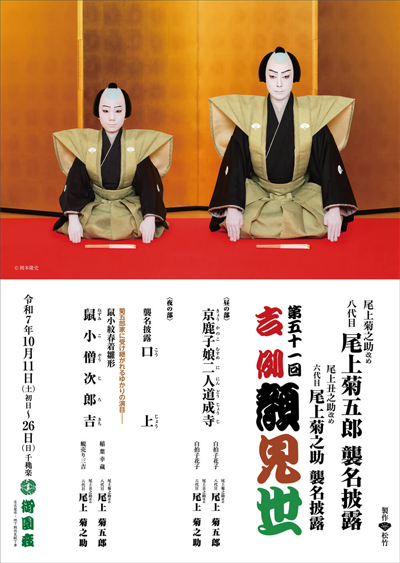 |
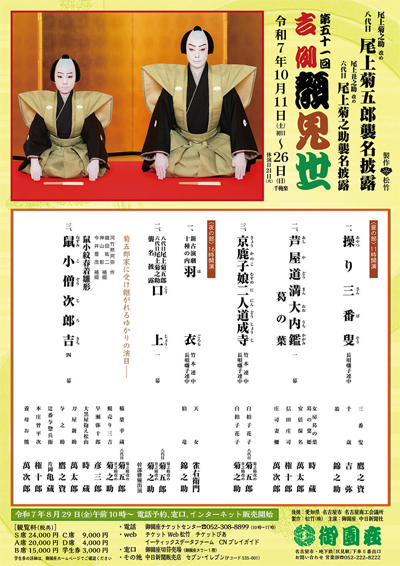 |
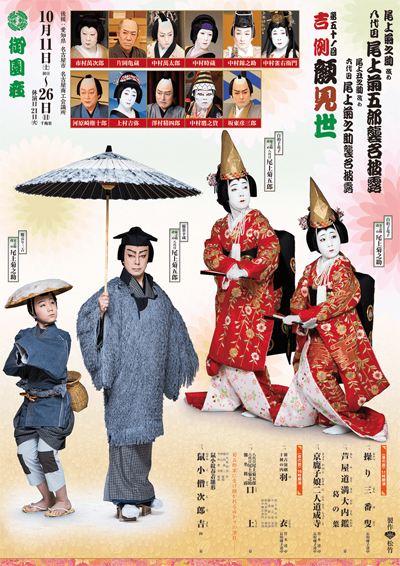 |
| Kabukiza (T˘ky˘) |  |
| Dates | 1 ~ 21 October 2025 Kinshű Jűgatsu ďkabuki Autumn Brocade October Grand Kabuki |
| 1st program |
|
| 2nd program |
|
| 3rd program |
|
| Casting |
Living National Treasure Kataoka Nizaemon, Living National Treasure Nakamura Baigyoku, Living National Treasure Nakamura Karoku, Living National Treasure Nakamura T˘z˘, Nakamura Shikan, Nakamura Manju, Nakamura Kaishun, Kataoka Takatar˘, Onoe Sh˘roku, Onoe Ukon, Band˘ Minosuke, Nakamura Hayato, Ichikawa Danko, Nakamura Matagor˘, Ichikawa Monnosuke, Band˘ Kamez˘, Ichikawa Emiya, Ichikawa En'ya, Ichikawa Juen, Nakamura Matsue, Nakamura Yonekichi, Band˘ Shingo, Nakamura Kash˘, Nakamura Tanenosuke, Nakamura Hashinosuke, Onoe Sakon, Ichikawa Seiko, Arashi Kitsusabur˘, Ichimura Kitsutar˘, Kataoka Matsunosuke, Nakamura Baika, Nakamura Kamenoj˘, Nakamura Tanetar˘, Nakamura Hidenosuke, Nakamura Haruki, Nakamura Natsuki, Ichikawa Ukon, Morita Oto |
| Comments |
The Autumn Brocade October Grand Kabuki at the Kabukiza, which features a full-length performance of one of the great classics of Kabuki, "Yoshitsune Senbon Zakura" (Yoshitsune and the Thousand Cherry Trees). This is an epic story about the famous 12th century general Minamoto no Yoshitsune fleeing from the wrath of his brother Minamoto no Yoritomo, after the end of the war. Although Yoshitsune is the title character, the main characters of the play are actually Tomomori, Gonta and Tadanobu, the heroes of the different sections of the play. This month is also the omemie of Morita Oto, the son of Band˘ Minosuke! There 2 different castings with 2 programs entitled A & B. Below, we've listed actors with a (Prog A/Prog B) format. If there is only one name, it means that the same actor performs the role in both programs.
|
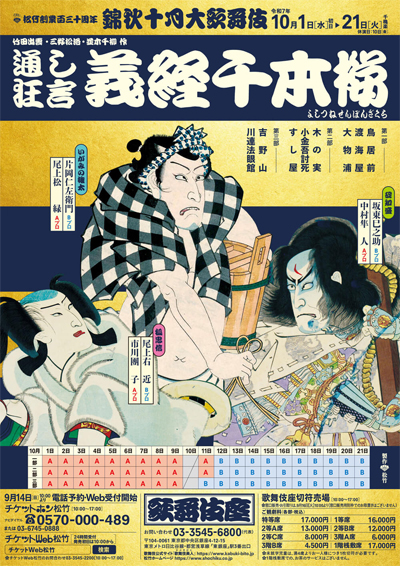 |
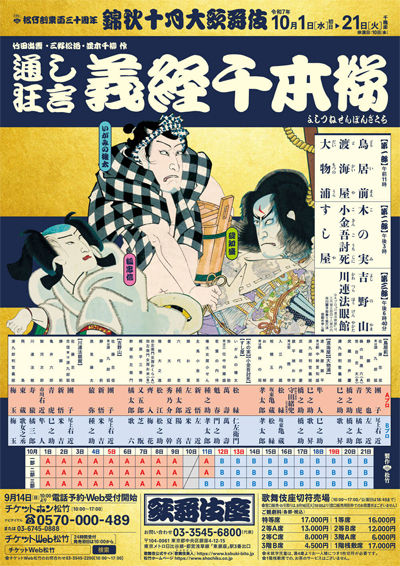 |
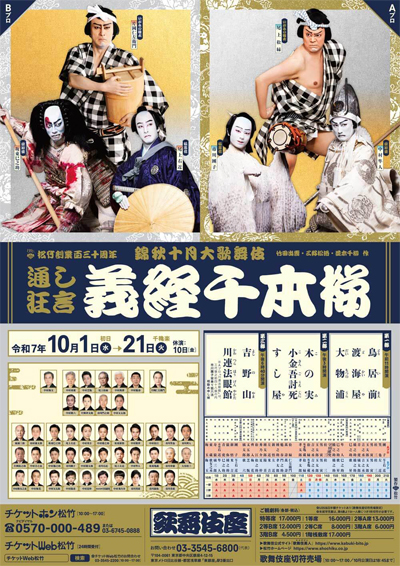 |
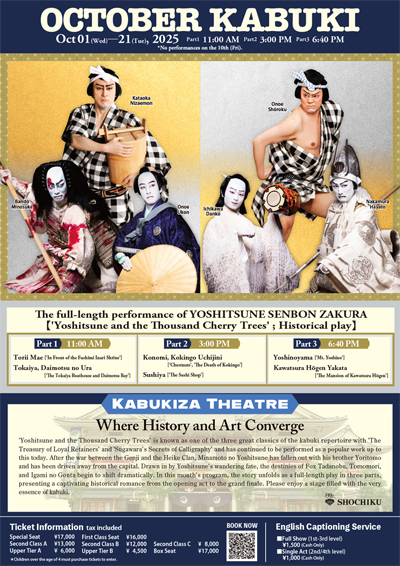 |
|
|||
| Dates | 1 ~ 6 October 2025 Ichikawa Danjűr˘ Tokubetsu K˘en Ichikawa Danjűr˘ Special Performance |
||
| MatinÚe |
Mimasu Sendai Hagi |
||
| Evening |
Invitation to KABUKI (Kabuki no Sekai)
|
||
| Casting |
Ichikawa Danjűr˘, Ichikawa Udanji, Kataoka Ichiz˘, Ichikawa Kudanji, Nakamura Toranosuke, ďtani Hiromatsu, Ichikawa Shinjűr˘, Ichikawa Masusabur˘ |
||
| Comments |
A special program starring Ichikawa Danjűr˘ in Fukuoka at the Hakataza.
|
||
|
|||
| Dates | 10 ~ 26 October 2025 Ichikawa Danjűr˘ Tokubetsu K˘en Ichikawa Danjűr˘ Special Performance |
| MatinÚe |
Mimasu Sendai Hagi |
| Evening |
Invitation to KABUKI (Kabuki no Sekai)
|
| Casting |
Ichikawa Danjűr˘, Ichikawa Udanji, Kataoka Ichiz˘, Ichikawa Kudanji, Nakamura Toranosuke, ďtani Hiromatsu, Ichikawa Shinjűr˘, Ichikawa Masusabur˘ |
| Comments |
A special program starring Ichikawa Danjűr˘ in Ky˘to at the Minamiza.
|
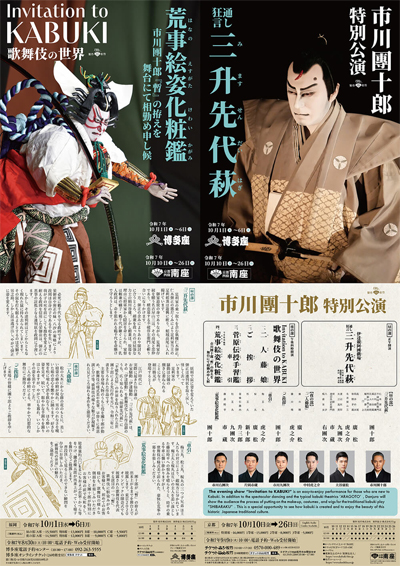 |
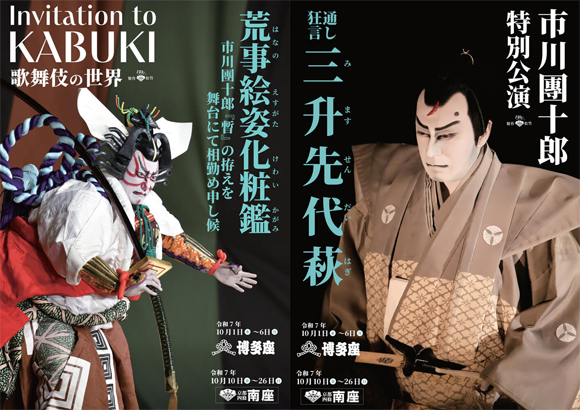 |
| Kinshű Special Tour | |
| Dates | 9 ~ 22 October 2025 Kinshű Tokubetsu K˘en Autumn Brocade Special Performances |
| Program |
Furţ T˘ku Hikari no Michishirube Shin |
| Casting |
Nakamura Kankur˘, Nakamura Shichinosuke, Nakamura Tsurumatsu, Nakamura Ich˘, Sawamura Kunihisa, Nakamura Nakasuke, Nakamura Nakashir˘, Nakamura Nakaya |
| Comments |
The word kinshű means "Autumn Brocade". This Autumn tour in 5 cities stars Nakamura Kankur˘ and Nakamura Shichinosuke. |
 |
| Sh˘chiku Grand Kabuki Tour | |
| Dates | 31 October ~ 25 November 2025 Sh˘chiku ďkabuki Sh˘chiku Grand Kabuki |
| Program |
Dorob˘ to Wakatono |
| Casting |
Nakamura Matagor˘, Nakamura Kash˘, Nakamura Tanenosuke, Nakamura Tanetar˘, Nakamura Hidenosuke |
| Comments |
The Sh˘chiku Grand Kabuki Fall Tour in 18 cities.
|
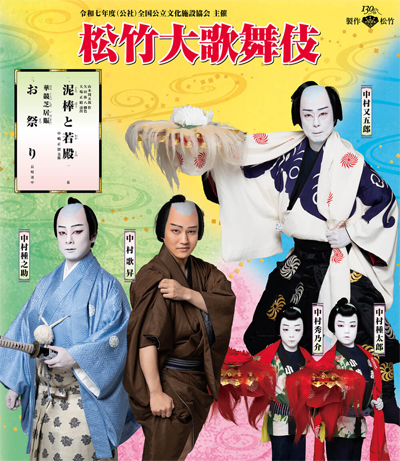 |
| Eirakukan (Toyooka) |  |
| Dates | 30 September ~ 5 October 2025 Eirakukan Kabuki Eirakukan Kabuki |
| Program |
K˘ no Tori |
| Casting |
Kataoka Ainosuke, Nakamura Kazutar˘, Band˘ Hikosabur˘, Nakamura Fukunosuke, Nakamura Utanosuke |
| Comments |
15th Kabuki program at the Eirakukan, a renovated traditional theater built in the city of Toyooka (prefecture of Hy˘go).
|
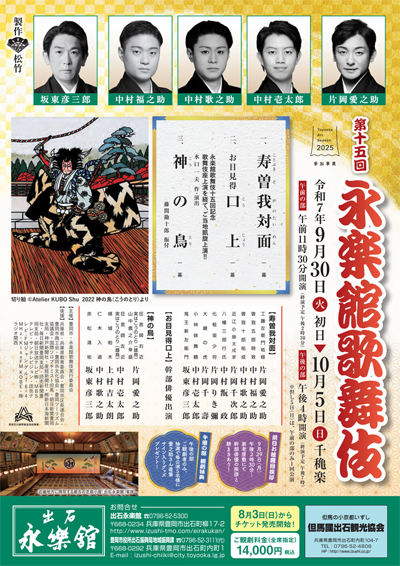 |
| Tachikawa Stage Garden (Tachikawa) | |
| Dates | 23 ~ 26 October 2025 Tachikawa Tachihi Kabuki Tokubetsu K˘en Tachikawa Tachihi Kabuki Special Performances |
| Program |
Goaisatsu | Kaisetsu Shinsetsu Oguri Hangan |
| Casting |
Nakamura Kazutar˘, Ichikawa Danko, Ichikawa Chűsha, Onoe Ukon, Ichikawa Emisabur˘, Ichikawa Emiya, Ichikawa En'ya, Ichikawa Seiko, Fujima Michinori |
| Comments |
A special Kabuki program staged in Tachikawa at the Tachikawa Stage Garden to celebrate the coming 100th anniversary of the creation of the Tachihi Group. Fujima Michinori III is the son of the dance master Fujima Kanjűr˘ VIII. |
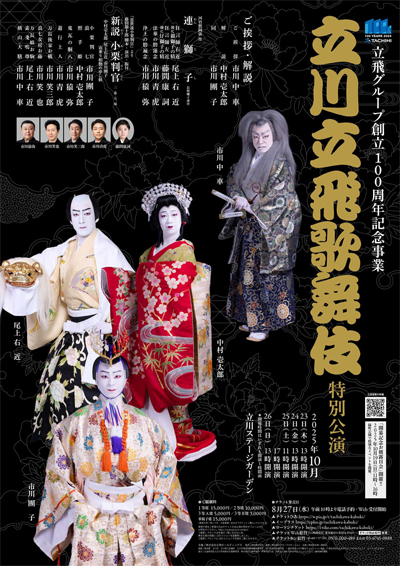 |
|
|||
| Dates | 3 October 2025 (Sh˘ no Kai) | ||
| Program | |||
| Casting | |||
| Comments |
10th edition of the Sh˘ no Kai, a gala program which stars Nakamura Tomijűr˘ V's son Nakamura Takanosuke. The guest star is Nakamura Kankur˘.
|
||
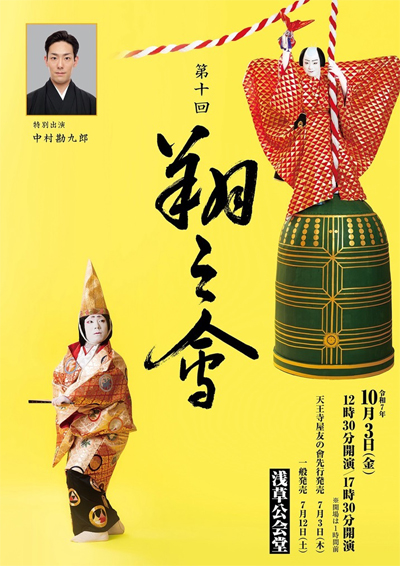 |
|
|
| Contact | Main | Top | Updates | Actors | Plays | Playwrights | Programs | Links | FAQ | Glossary | Chronology | Illustrations | Prints | Characters | Derivatives | Theaters | Coming soon | News |
